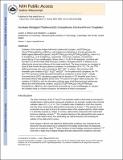| dc.contributor.author | Wilson, Justin J. | |
| dc.contributor.author | Lippard, Stephen J. | |
| dc.date.accessioned | 2013-11-18T19:19:20Z | |
| dc.date.available | 2013-11-18T19:19:20Z | |
| dc.date.issued | 2012-09 | |
| dc.date.submitted | 2012-06 | |
| dc.identifier.issn | 0020-1669 | |
| dc.identifier.issn | 1520-510X | |
| dc.identifier.uri | http://hdl.handle.net/1721.1/82407 | |
| dc.description.abstract | Oxidation of the acetate-bridged half-lantern platinum(II) complex cis-[Pt[superscript II](NH[subscript 3])[subscript 2](μ-OAc)[subscript 2]Pt[superscript II](NH[subscript 3])[subscript 2]](NO[subscript 3])[subscript 2], [1](NO[subscript 3])[subscript 2], with iodobenzene dichloride or bromine generates the halide-capped platinum(III) species cis-[XPt[superscript III](NH[subscript 3])[subscript 2](μ-OAc)[subscript 2]Pt[superscript III](NH[subscript 3])[subscript 2]X](NO[subscript 3])[subscript 2], where X is Cl in [2](NO[subscript 3])[subscript 2] or Br in [3](NO[subscript 3])[subscript 2], respectively. These three complexes, characterized structurally by X-ray crystallography, feature short (≈2.6 Å) Pt–Pt separations, consistent with formation of a formal metal–metal bond upon oxidation. Elongated axial Pt–X distances occur, reflecting the strong trans influence of the metal–metal bond. The three structures are compared to those of other known dinuclear platinum complexes. A combination of [superscript 1]H, [superscript 13]C, [superscript 14]N, and [superscript 195]Pt NMR spectroscopy was used to characterize [1][superscript 2+]–[3][superscript 2+] in solution. All resonances shift downfield upon oxidation of [1][superscript 2+] to [2][superscript 2+] and [3][superscript 2+]. For the platinum(III) complexes, the [superscript 14]N and [superscript 195]Pt resonances exhibit decreased line widths by comparison to those of [1][superscript 2+]. Density functional theory calculations suggest that the decrease in the [superscript 14]N line width arises from a diminished electric field gradient at the [superscript 14]N nuclei in the higher valent compounds. The oxidation of [1](NO[subscript 3])[subscript 2] with the alternative oxidizing agent bis(trifluoroacetoxy)iodobenzene affords the novel tetranuclear complex cis-[(O[subscript 2]CCF[subscript 3])Pt[superscript III](NH[subscript 3])[subscript 2](μ-OAc)[subscript 2]Pt[superscript III](NH[subscript 3])(μ-NH[subscript 2])][subscript 2](NO[subscript 3])[subscript 4], [4](NO[subscript 3])[subscript 4], also characterized structurally by X-ray crystallography. In solution, this complex exists as a mixture of species, the identities of which are proposed. | en_US |
| dc.description.sponsorship | National Cancer Institute (U.S.) (Grant CA034992) | en_US |
| dc.description.sponsorship | National Institutes of Health (U.S.) (Grant 1S10RR13886-01) | en_US |
| dc.description.sponsorship | David H. Koch Cancer Research Fund (Fellowship) | en_US |
| dc.language.iso | en_US | |
| dc.publisher | American Chemical Society (ACS) | en_US |
| dc.relation.isversionof | http://dx.doi.org/10.1021/ic301289j | en_US |
| dc.rights | Article is made available in accordance with the publisher's policy and may be subject to US copyright law. Please refer to the publisher's site for terms of use. | en_US |
| dc.source | PMC | en_US |
| dc.title | Acetate-Bridged Platinum(III) Complexes Derived from Cisplatin | en_US |
| dc.type | Article | en_US |
| dc.identifier.citation | Wilson, Justin J., and Stephen J. Lippard. “Acetate-Bridged Platinum(III) Complexes Derived from Cisplatin.” Inorganic Chemistry 51, no. 18 (September 17, 2012): 9852-9864. | en_US |
| dc.contributor.department | Massachusetts Institute of Technology. Department of Chemistry | en_US |
| dc.contributor.mitauthor | Wilson, Justin J. | en_US |
| dc.contributor.mitauthor | Lippard, Stephen J. | en_US |
| dc.relation.journal | Inorganic Chemistry | en_US |
| dc.eprint.version | Author's final manuscript | en_US |
| dc.type.uri | http://purl.org/eprint/type/JournalArticle | en_US |
| eprint.status | http://purl.org/eprint/status/PeerReviewed | en_US |
| dspace.orderedauthors | Wilson, Justin J.; Lippard, Stephen J. | en_US |
| dc.identifier.orcid | https://orcid.org/0000-0002-2693-4982 | |
| mit.license | PUBLISHER_POLICY | en_US |
| mit.metadata.status | Complete | |
